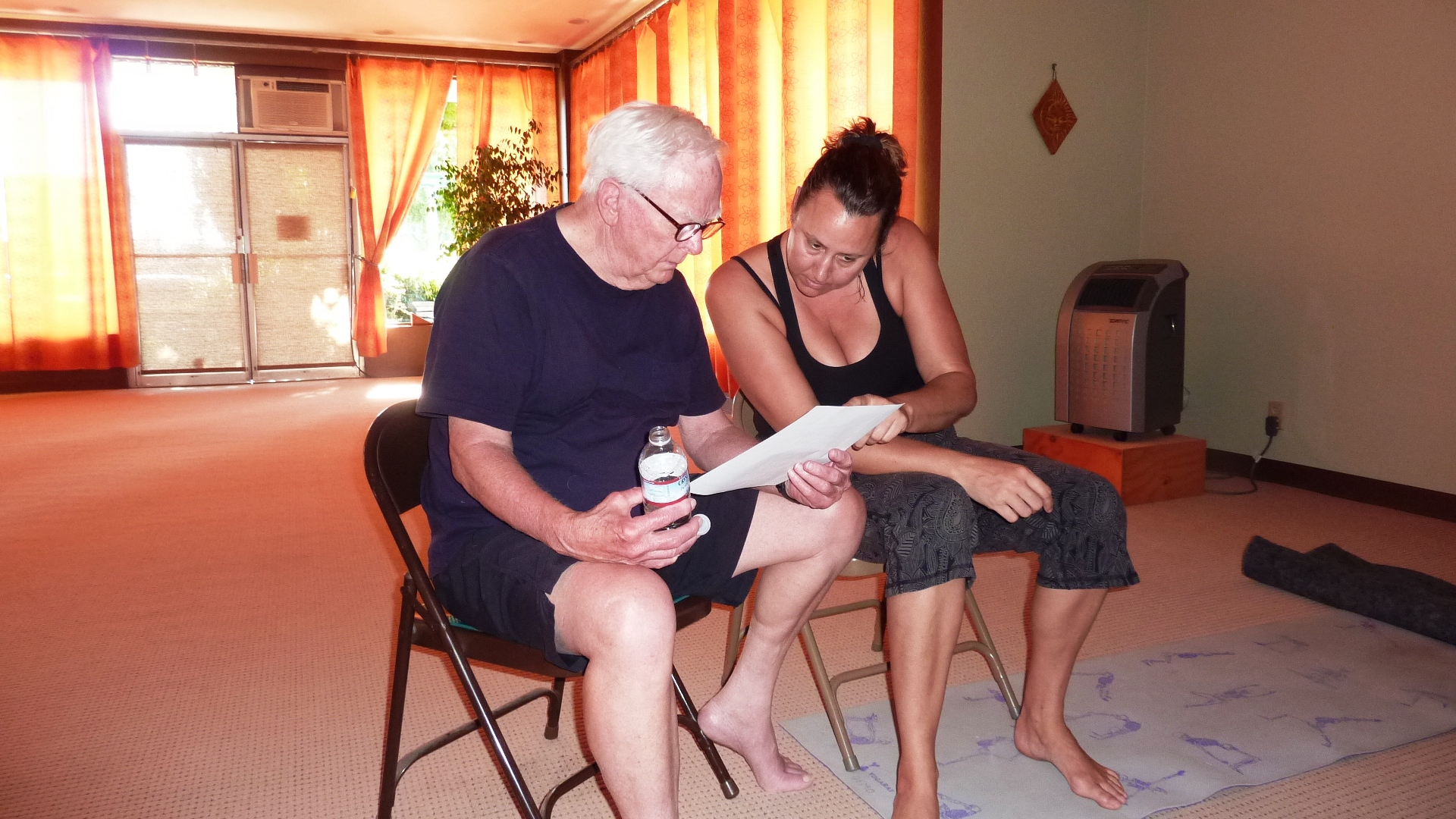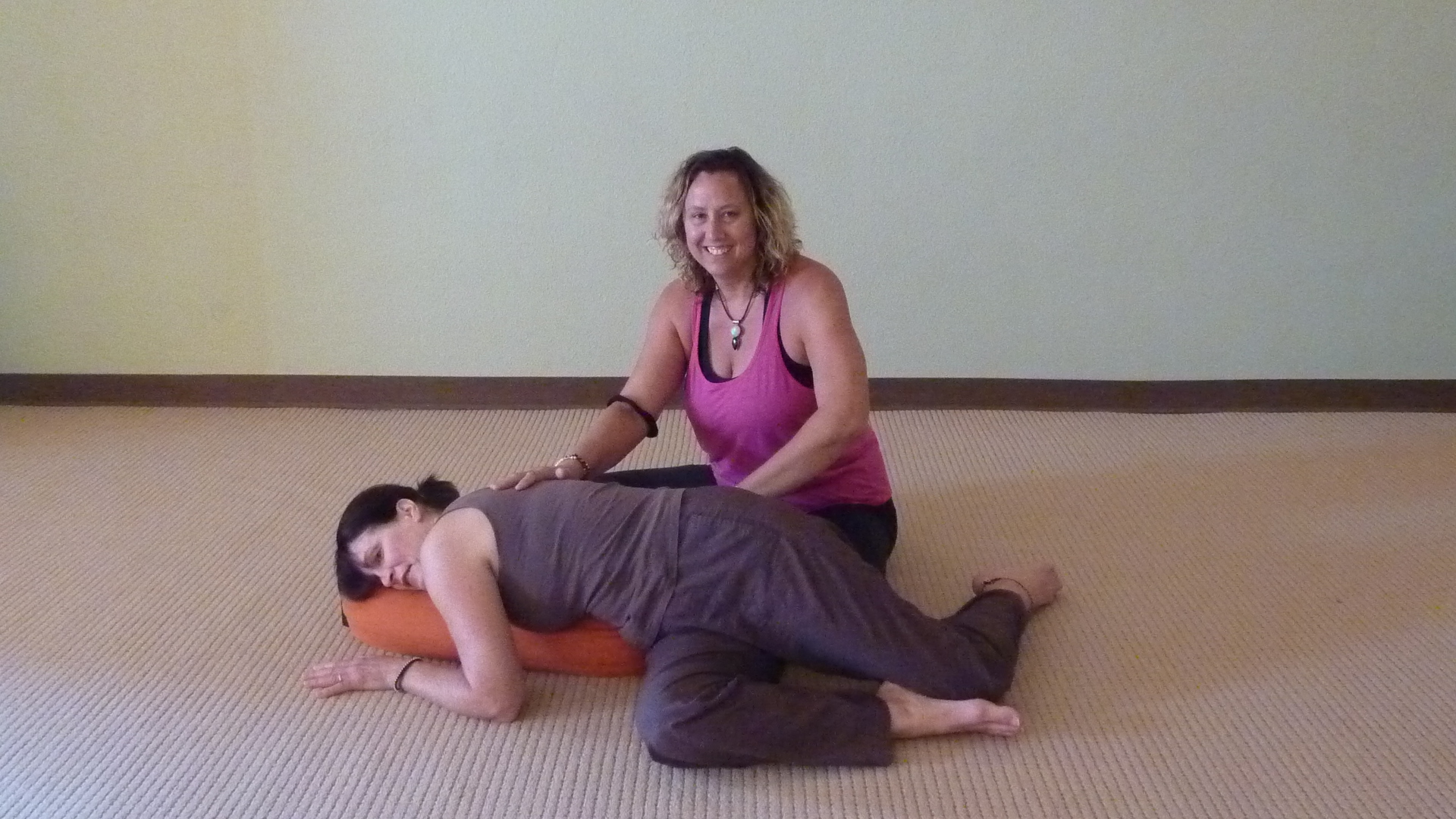Considerations in Teaching Yoga Using Study Protocols by Justine Shelton, C-IAYT
Overview
Protocols are needed for studies to confirm that Yoga is indeed effective in treating Chronic Low Back Pain. Their nature is to take an asana treatment plan that can be applied across a broad population to substantiate the positive effects of the practice. The privilege Yoga Teachers have in using Yoga as a therapeutic tool with our students is to individualize the application of asana to benefit each person and their individual needs based on their condition, whether in a group setting or private session. The need to bridge a protocol-based approach with an individualized asana approach led me to develop a comprehensive online ‘Gentle Yoga for Low Back Care’ Teacher Training Program in order to educate Yoga teachers on the anatomy, bio-mechanics and therapeutic asana modifications required when working with people with low back injuries and specific spinal conditions. In this way we can affect the deepest level of positive change for each person we educate to use the tools of Yoga asana in regards to their specific body and conditions.
As a Yoga Therapist specializing in Yoga for the Low Back, I am thrilled Western medicine and research are finding that Yoga is effective for many things, including CLBP (Chronic Low Back Pain). As someone who started teaching ‘Yoga for a Healthy Back’ classes in 2008, they are preaching to the choir! Yoga has helped me personally to manage my back pain and conditions quite well – and all the more so after I got an MRI diagnosis (after a debilitating episode of back spasms in 2009) and realized much of the Yoga I was doing was actually hurting my back. Getting this diagnosis in the midst of my Viniyoga Teacher training was serendipitous as I was able to apply my knowledge of contraindications for my specific conditions and created asana practices designed to help improve my back. I always tell people, “Yoga can heal, Yoga can harm. It depends on the proper application.” And if there is a diagnosis to help us understand what is going on, all the better – knowledge is power.
The Diagnosis Dilemma
In the above-referenced study, “The group recommends that people with back pain should avoid pain medicines if possible, and instead opt for alternatives such as tai chi, yoga and massage. As we’ve reported, those guidelines are aimed at people with run-of-the-mill back pain, rather than pain due to an injury or other diagnosed problem.” So, ‘run-of-the-mill’ back pain, sometimes referred to as ‘generalized’ or ‘chronic’ low back pain……therein lies the challenge. If ‘generalized low back pain’ is the diagnosis, that is medical speak for: ‘we don’t know what is wrong.’ Just like me, pre-MRI, many people don’t know what is wrong with their back and/or don’t have a specific diagnosis. The profile of the participants in this study were predominantly low-income participants. Questions worth asking would be: Did they have access to MRIs or other diagnostic tests? Was there an effort to rule out major injuries and conditions? If the participant had an MRI, was it reviewed to discern what their low back dysfunction was? Without understanding each participants anatomical issues that relate to their low back pain, applying specific Yoga asanas to the entire group may have contraindications for some, and be helpful to others. That is the fine line of any protocol-based program. So, while I am thrilled Yoga is being viewed as a viable option to combat back pain – I am also highly dedicated to Yoga asana not causing harm in individuals who try it!
 The article has links to the Participant Guidebook as well as the Teacher Training Manual used for teaching this protocol. Using a ‘protocol’ assumes a ‘one size fits all’ approach to healing and provides measured results which are important for substantiating generalized findings. A great first step to offering help for CLBP sufferers.
The article has links to the Participant Guidebook as well as the Teacher Training Manual used for teaching this protocol. Using a ‘protocol’ assumes a ‘one size fits all’ approach to healing and provides measured results which are important for substantiating generalized findings. A great first step to offering help for CLBP sufferers.
Quite honestly, many students who walk into our classes are in this boat: there is pain, but they don’t know exactly what is causing it. So, it us up to us as Yoga Teachers and/or Yoga Therapists to know what questions to ask and to teach poses that are safest for the lowest common denominator in the room – limiting risks to the students. If we are seeing these clients privately for sessions we have more opportunity to ask these questions and help determine not only what asana won’t hurt them, but also what asana will help them improve their condition, strengthen their musculature and hopefully get them out of pain or at least functioning much better.
Protocol Knowledge Gap
In the study guidelines, they ask the subjects to do all the poses to the best of their ability. This is in order to create generalizability of the results of the study. In the study Participant Guidebook , it is stated to listen to their body and not do anything that hurts them – they can ask the teacher for modifications of the pose. This states the importance of the teacher knowing HOW to modify the poses. I heard from many Yoga teachers who want to teach this protocol to help their CLBP students. I am excited about the interest in helping this student community through Yoga and believe there is one more very important component to the long-term success of this program’s protocol. There is a need to empower the Yoga Teacher/Yoga Therapist by filling in the knowledge gap of understanding the anatomy and biomechanics of the various low back injuries and conditions. In this way, Yoga Teachers will know how, when and why to offer modifications for the protocol asanas to keep their students safe, and not just follow an asana script.
When There is Not a Diagnosis
When there is not a diagnosis, but there is low back pain, teachers need to know what questions to ask in order to better understand the dysfunction that may be happening in their student’s body. Over the years I have worked with people with many varying back conditions and I have learned to ask the right questions to ‘get inside my student’s bodies’ so to speak.
- Is the pain on one side of the low back or across the low back? If they point to their SI Joint on one side we need to know how to stabilize the SI Joints and avoid poses that put sheer stress on the SI Joints.
- Is it knife-like, stabbing, shooting, tingling? To determine if it is generally an achy muscle or if there is nerve involvement.
- Is the pain worse in the morning when you get out of bed or as the day goes on? This can tell us if the pain is mostly stiffness in the muscles or something more serious.
- Is the pain local to your lower back or does it travel down your leg(s) or up your back? This can also give us clues as to nerve involvement and if a localized injury is progressing.
For those teachers not teaching from a CLBP protocol, it is important to create a sequence of poses for our students that are safe and follow contraindications for conditions – so we are working in the direction of positive change and not creating more dysfunction or pain. Some strategies for safe sequencing would be:
- starting class on the back, possibly with knees bent, so that the entire spine is supported in axial extension;
- stretching the musculature of the lower back with a forward bend first – such as apanasana;
- preparation of the musculature before going into stronger poses;
- using forward bends to bring the spine back to neutral;
- starting with symmetrical poses versus asymmetrical poses to avoid sheer stress on the sacroiliac (SI) joints;
- stabilizing the SI joints after asymmetrical poses and/or knowing when to avoid asymmetrical poses altogether;
- compensation for poses throughout the practice to avoid cumulative stress;
- knowing when a twist is safe and how to modify it for someone who shouldn’t rotate the lumbar spine too far, or at all.
Putting Theory into Practice
Let’s look at this theory in practice. I’ll use myself as a case in point. I have had back pain since I was a teenager – no surprise as I rode horses, barrel raced, played basketball, lifted weights and generally wreaked havoc on my body! When I practiced Yoga, back bends hurt me and deep back bends hurt me quite a bit. Even a supported backbend on a bolster would leave me in pain. Now I know that is because I have central and foraminal spinal stenosis. This clued me into the fact that back bends compress the space in the spinal canal, as well as the foramen where the nerves pass through on their way out of the spinal column to the body – hence, annoying the stenosis and causing pain….whereas forward bends open that same space and provide relief. Oftentimes, disc damage is relieved by back bends as they can help retract the discs back into place.
 Many people, including myself, have both disc damage and stenosis or osteoarthritis of the lumbar spine – how do we balance that? What helps one may hurt the other. My answer would be….very carefully! Prone, repetitive back bends when the stenosis is not acute will strengthen the musculature of the back and help the lumbar discs retract without bringing the lumbar spine into too deep of extension and triggering the stenosis, which may cause muscle spasms. Forward bends, such as repetitive apanasana (lying on your back and bringing the knees into the chest) are beneficial not only for the stenosis, but also for imbibing the lumbar discs with fluid hence creating more space between the vertebral bodies, and the discs are safe because the spine is supported by the floor in axial extension. A standing forward bend, such as uttanasana, is also safe for the lumbar discs AS LONG AS the sacrum is tilted in the same direction as the lumbar spine – this happens by deeply bending the knees so the sacrum can tilt forward and the lumbar spine doesn’t hinge.
Many people, including myself, have both disc damage and stenosis or osteoarthritis of the lumbar spine – how do we balance that? What helps one may hurt the other. My answer would be….very carefully! Prone, repetitive back bends when the stenosis is not acute will strengthen the musculature of the back and help the lumbar discs retract without bringing the lumbar spine into too deep of extension and triggering the stenosis, which may cause muscle spasms. Forward bends, such as repetitive apanasana (lying on your back and bringing the knees into the chest) are beneficial not only for the stenosis, but also for imbibing the lumbar discs with fluid hence creating more space between the vertebral bodies, and the discs are safe because the spine is supported by the floor in axial extension. A standing forward bend, such as uttanasana, is also safe for the lumbar discs AS LONG AS the sacrum is tilted in the same direction as the lumbar spine – this happens by deeply bending the knees so the sacrum can tilt forward and the lumbar spine doesn’t hinge.
Low Back Conditions and Aging Considerations
What other conditions may we see in our Yoga classes? Remember, the biggest population group coming to Yoga is made up of Baby Boomers. We need to know how to take care of this group as well, not all our students will be twenty-something’s with no injuries or dysfunction in their structures (my twenty-something self had a lot of injuries from sports, as do many others…..so even the ‘healthy’ 20 year old is an assumption that may not be correct!) Osteopenia, osteoporosis, degenerative disc disease (DDD), spondylolisthesis or retrolisthesis, etc. can all play havoc on low back health and have different manifestations and mobility challenges.
Once we understand the mechanics of the body and the healing process we can apply our Yogic knowledge of asana as a way to support improvement of the biomechanics of the body, increase circulation to areas of injury, stabilize what is weak, release what is chronically contracted, create more space and increase mobility.
Conclusion
As a Yoga Therapist, I applaud that the study states: “The use of the breath is what makes yoga different from other exercise. You should remember to take slow even yoga breaths with each pose.” The meditative and breathing aspect of an asana practice cannot be minimized, as well as the way Yoga addresses us on every level – physical, mental and emotional. Helping us to deal with pain on every level.
We live in an exciting time when studies are being done to scientifically support the benefits of Yoga practice. Those studies have constraints placed on them by the sheer nature that they need broad based populations practicing the same sequences to make the study valid and generalizable. By design, and for the greatest good, they are not meant to be individualized! As Yoga Teachers and Yoga Therapists we have an awesome privilege of being able to use our knowledge to take those scientific findings and go a step further by offering our students and clients a more unique practice that serves their specific needs. I’m grateful for this time when Western Medicine and the practice of Yoga work hand in hand to empower more people to take their health into their own hands.
Learn More about Teaching Yoga for Chronic Low Back Pain
Are you a Yoga Teacher or Yoga Therapist interested in learning more about the specific conditions and injuries that affect Low Back health? Are you interested in learning how to modify Yoga asanas to help support and heal chronic low back pain in yourself or in your students? If so, come learn with us at the Yoga Vista Academy! Find out more about our Online Gentle Yoga for Low Back Care Specialty Certification Program.
©Copyright: Yoga Vista Academy and Justine Shelton



